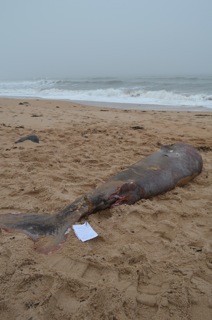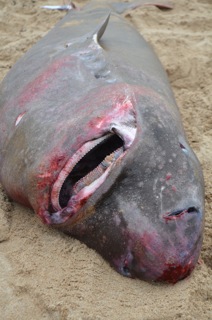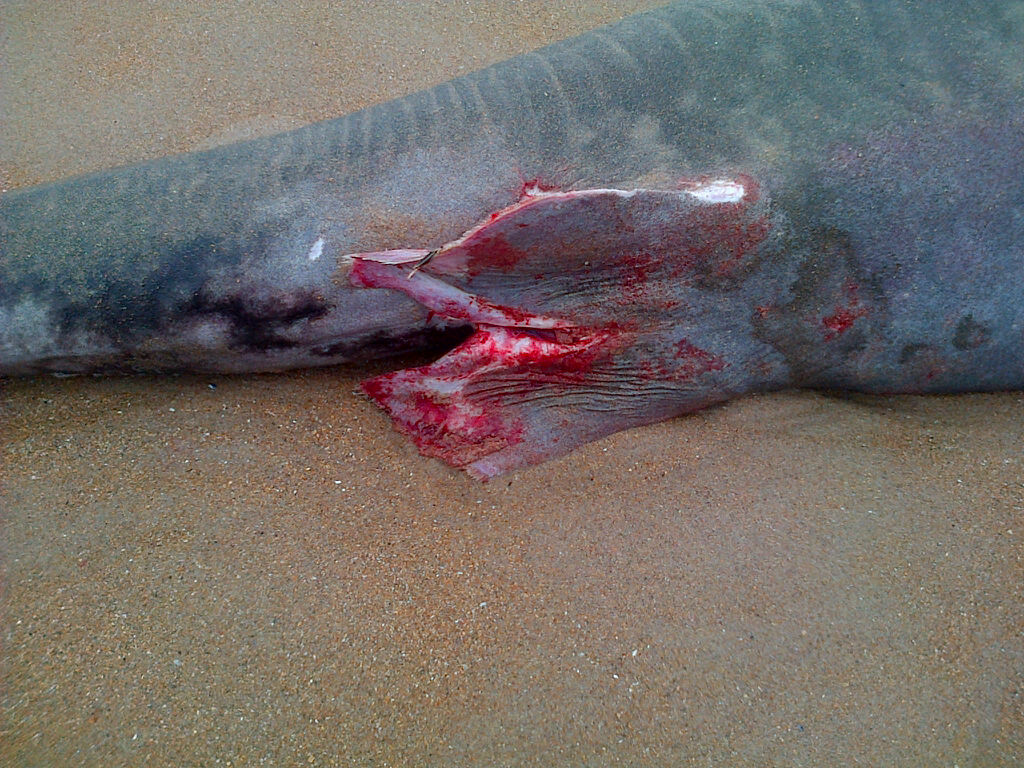An unusual stranding occurred on Friday morning when a 3m Greenland shark (Somniosus microcephalus) washed up on a beach by Dunstan Steads, outside Alnwick, Northumberland.
It was discovered by James Robertson, a local farmer, who was out surfing. James called in his observation to the local council and to Dr Per Berggren at the School of Marine Science & Technology who coordinated the recovery of the shark. It was a truly collaborative effort involving local efforts to get the animal off the beach in the late afternoon and then transported in the School van by Marine Science Technician John Knowles from The Dove Marine Laboratory. John then got help from Marine Science MPhil students Andrew Temple and Will Jolly, and Dan Gordon (Great North Hancock Museum) to get the shark into the freezer room at the Dove Marine Lab where it is now sharing the space with six porpoises and one hooded seal.

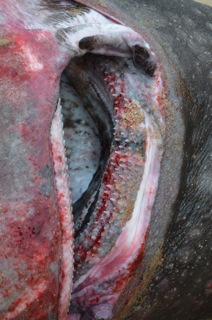 The Greenland shark is a sub-Arctic species with possibly the most northern distribution of any shark and is normally found around Iceland and Greenland. It belongs to the family “sleeper” sharks (Somniosidae) within the order dogfishes (Squaliformes) and is also sometimes called Gurry shark (due to the fact that it sometimes eat offal from fish and mammals). It inhabits inshore zones to continental shelves usually in depths of 0 to 1200 m (has been recorded at 2,200m depth). During winter months in the species occurs in the intertidal zone and at the surface in shallow bays and river mouths, moving into depths of 180 to 550 m during warmer months.
The Greenland shark is a sub-Arctic species with possibly the most northern distribution of any shark and is normally found around Iceland and Greenland. It belongs to the family “sleeper” sharks (Somniosidae) within the order dogfishes (Squaliformes) and is also sometimes called Gurry shark (due to the fact that it sometimes eat offal from fish and mammals). It inhabits inshore zones to continental shelves usually in depths of 0 to 1200 m (has been recorded at 2,200m depth). During winter months in the species occurs in the intertidal zone and at the surface in shallow bays and river mouths, moving into depths of 180 to 550 m during warmer months.
The Greenland shark is fairly barrel shaped with a short, rounded snout, small dorsal and pectoral fins, and small eyes. The gill openings are also very small in relation to the size of the species. The colour range from dark brown to pale grey and is uniform.
It is one of the largest sharks and can grow up to 7m and way 1400kg. The animal that stranded was comparatively small being 3m and about 120kg. There are no reliable estimates of the Greenland shark lifespan but tagged sharks have been recaptured 16 years later. It is thought to grow at very slow rate and may be the longest-lived vertebrate with a potential life span of over 200 years. It has placental ovoviviparous reproduction and the female can carry up to 10 young pups.
Greenland shark is an apex predator that normally feeds on fish, seabirds, seals, invertebrates and large carcasses. It has about 50 teeth in each the upper and lower jaw. The teeth of the upper jaw are thin, pointed, without serrations and act as anchor while the lower jaw does the cutting. The lower teeth are broad, square and interlocking with short cusps pointing outward. Most shark species can be identified from their teeth and for this species it is important to use teeth from both upper and lower jaw for a positive identification.
 This shark is listed as Near Threatened on the basis of possible population declines and limiting life history characteristics. The Greenland shark was historically targeted by shark liver fisheries in Norway, Iceland, and Greenland that may have had a significant impact on the species. The commercial fishing of the Greenland shark for liver oil ended in 1960. Currently the species is taken as bycatch in halibut and shrimp trawl fishers and fish traps and gillnets in Greenland. It is also caught by artisanal fisheries in the Arctic.
This shark is listed as Near Threatened on the basis of possible population declines and limiting life history characteristics. The Greenland shark was historically targeted by shark liver fisheries in Norway, Iceland, and Greenland that may have had a significant impact on the species. The commercial fishing of the Greenland shark for liver oil ended in 1960. Currently the species is taken as bycatch in halibut and shrimp trawl fishers and fish traps and gillnets in Greenland. It is also caught by artisanal fisheries in the Arctic.
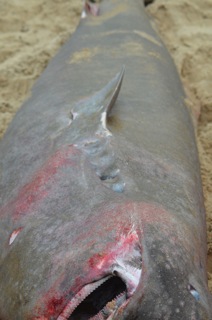 The flesh of a Greenland shark is poisonous due to the presence of the trimethylamine oxide. However, it can be eaten if it is boiled in several changes of water or dried or fermented for several months to produce Hákarl. Traditionally Hákarl this was produced by burying the shark in the ground, where the shark would go through several cycles of freezing and thawing. It is considered a delicacy in Iceland and Greenland.
The flesh of a Greenland shark is poisonous due to the presence of the trimethylamine oxide. However, it can be eaten if it is boiled in several changes of water or dried or fermented for several months to produce Hákarl. Traditionally Hákarl this was produced by burying the shark in the ground, where the shark would go through several cycles of freezing and thawing. It is considered a delicacy in Iceland and Greenland.
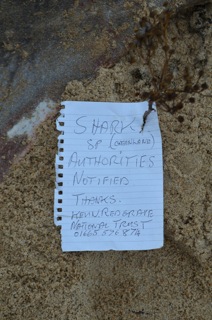 What will happen to the shark now? The shark will be kept frozen until a decision has been made of its fate. There is great interest for the shark and the Natural History Museum is interested in preserving the whole animal but before that the animal will be measured and sampled for biological and ecological analyses.
What will happen to the shark now? The shark will be kept frozen until a decision has been made of its fate. There is great interest for the shark and the Natural History Museum is interested in preserving the whole animal but before that the animal will be measured and sampled for biological and ecological analyses.
For more information please contact: Dr Per Berggren (per.berggren@ncl.ac.uk)
The pictures of the shark have kindly been provided by Darren Graham, Northumberland and James and Elizabeth Robertson.
Inshore Fisheries and Conservation Authority (IFCA).

